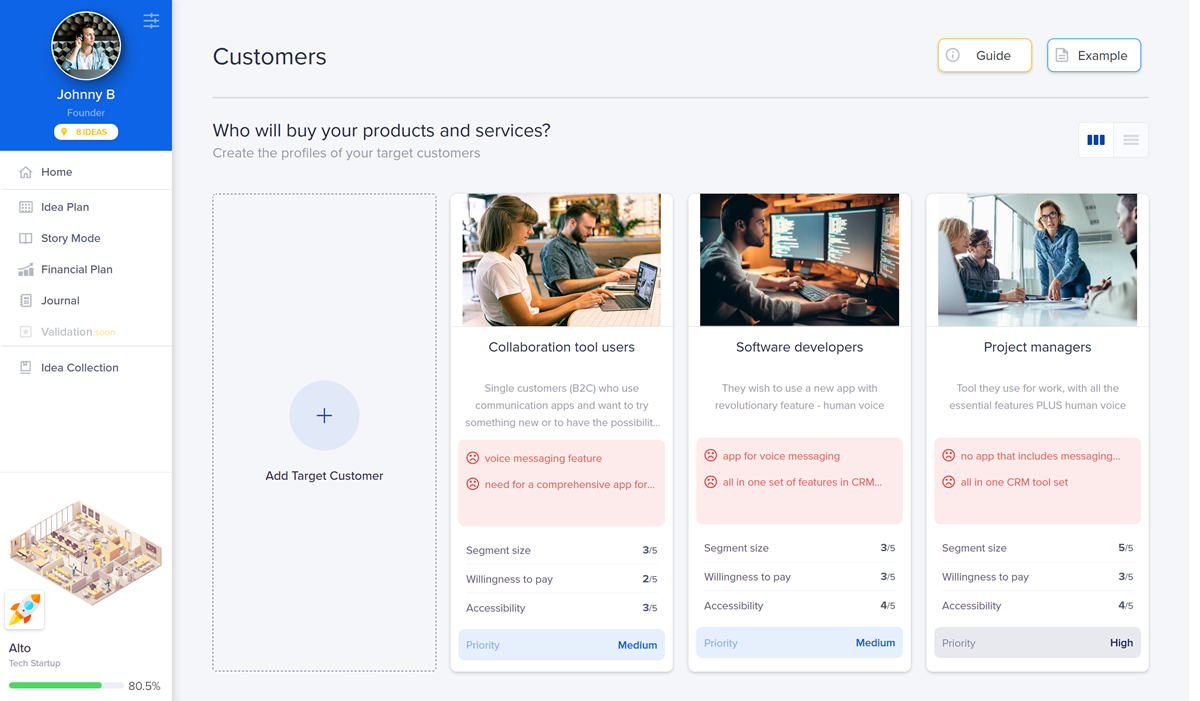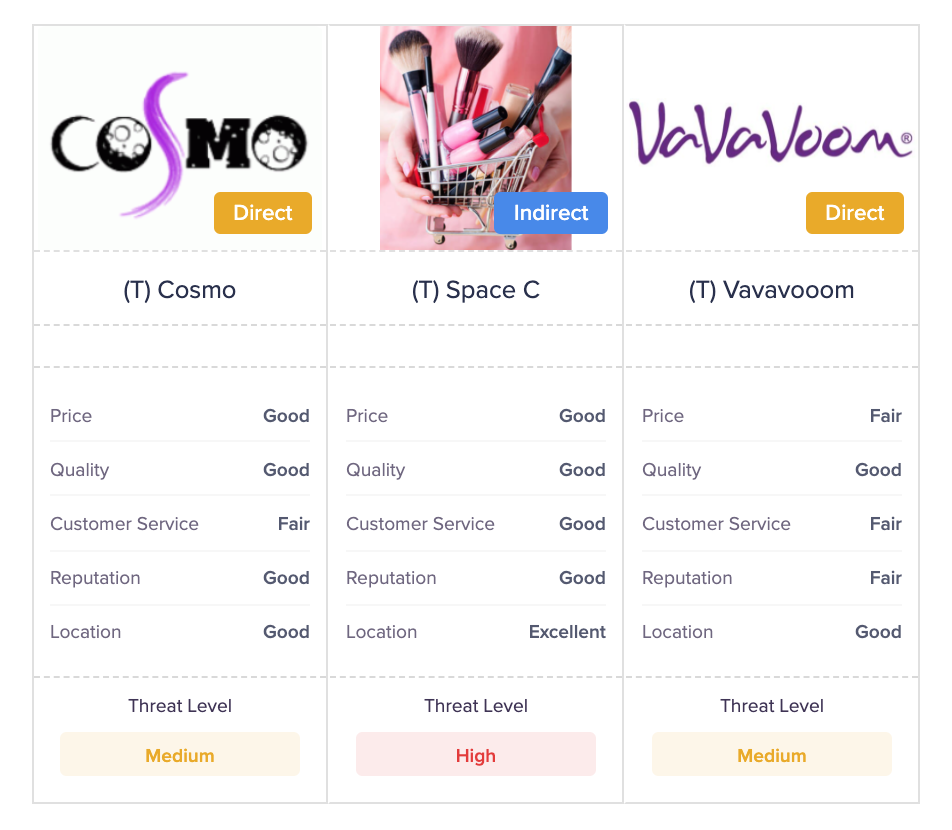Let’s try to guess – you have an amazing idea, but you feel completely lost and clueless since you don’t know how to turn it into reality and start a small business?
If so, you should know that you’re not alone.
Many entrepreneurs have stood where you stand — on the verge of a breakthrough with a killer business concept, but unsure about the first steps to start a small business. Feelings of insecurity and constant questioning are only natural when you have something precious in your head, but don’t know how to shape it into something visible and substantial.
Starting a small business out of nothing sounds frightening, but it’s far from impossible!
In today’s blog, we’ll show you what are all the steps to start a small business and provide you with details that you might need to know.
How to start a small business
Here are the eight steps you need to go through if you want to start a small business:
- Pick the right idea
- Make a simple one-page plan
- Build a business concept
- Research the market
- Test the concept
- Write a proper business plan
- Determine funding requirements
- Make financial projections
By the time you are done reading this article, you will know everything you need (and more) to turn your dreams into reality and start a small business!
1. Pick the Right Idea

Even the best of ideas remain completely worthless until you do something about it.
Luckily, you are full of them!
Some are years old, some were born at college during a chill game of Beer Pong, and some sounded so good to you that you wrote them down and kept coming back to them, tweaking, tinkering, scaling them up and down.
We pondered some of the common motivations for starting out on your own, and the right mindset you need to have before developing your business in our previous article.
We highly suggest you read it, to get a better idea about the life-changing journey you’re about to go on. You’ll also learn how to assess your skills, knowledge, and personality so you can unlock your hidden potential.
Now it’s time to pick a single idea and stick to it until the very end.
But how to choose the right one? Determining whether there is a strong market demand for your product or service is the first step when starting a successful business venture. Skip it at your peril!
Look for the best product market fit. This remains one of the most important factors when picking an idea you want to stick with.
Then, look hard at whether it goes along with the things you are passionate about. All the money in the world won’t be enough if you wake up one day and realize you hate your work.
You will have to trust your gut instinct and be as rational as possible. This step is the main thing that differentiates a successful business from a daydream or a hobby. Unfortunately, the market doesn’t care about your hopes and dreams, so you will have to pick the idea others will care about enough to pay for it.
2. Make a One-Page Plan
Before you start to develop the details, you should first create a one-page plan to quickly summarize your vision of a small business. A one-page plan is, practically speaking, a piece of paper where you will structure your idea and put all the goals and assumptions related to your business model in one place.
It will help you to get more familiar with your idea and get a general view of it before getting to the finer points. You will paint a picture of your business model in a nutshell, designed to fit a single, concise page.
Sketch it out, define the basics, and see if it makes sense.
Spend some quality time alone with your draft. The best thing about this stage is that you don’t need to invest tons of money or spend a lot of time bringing the idea to life.
You just need a bullet-proof business model.
There are plenty of templates for one-page plans to choose from, but we recommend using our Idea Plan.
3. Develop a Business Concept
This is where you get back to the first version of your idea and start detailing every aspect of it. Take into consideration all the suggestions you’ve been given, along with the new ways you came up with to make your idea better.
Your business concept is a full-fledged composition of all the elements required to develop a profitable business — including your unique selling proposition, final products and services, promotional tactics, and sales channels.
Create your unique selling proposition
Your unique selling proposition is the most important part of the business concept as it tells us what differentiates your products and services from those of your competitors — such as the lowest cost, the highest quality, or the first-ever product of its kind. It is what you have that competitors don’t.

Think about the promotion tactics
No matter how good your products and services are, it’s unlikely they will sell on their own unless you make other people aware of them. There are many different promotional strategies that you can use to stand out and be noticed, but you need to focus on the ones that will be the most effective.
Define your sales strategy
Will you distribute your product or service through a website or the mail? Are you going to use sales representatives or home delivery, or do you plan to sell it exclusively through retail? This all depends on the type of product you will be selling, your market affinities, and whether you will have a middleman to help distribute products quickly and efficiently.
Build a prototype
After you have defined your business concept, you can create a demo version/prototype/ PowerPoint slideshow. Make it usable for a few consumers or, if you are making a presentation, include enough info so people get the right idea.
“What if my concept fails, or even worse — what if the whole venture fails?!”
Everyone asks themselves this question. But why not ask yourself a better one: what if it works?
People love the example of Jack Ma, one of the richest men in the world. He most certainly wouldn’t be where he is now if he gave up during his early attempts to get his career going.
“Fall ten times, get up eleven”
Even if you don’t manage to succeed the first time, you can try again. Use your failed attempt as a case study, and examine it from all sides to see what brought you down — so you don’t repeat the same mistakes.
And keep in mind that starting out with a prototype, as we outlined above, will cut down greatly on this risk of failure.
4. Test the Concept
When you are done with the fundamental version, it is time to make it public — for a limited number of people. Concept validation starts with your immediate connections.
Share the initial version with your network and note their reactions. Are they intrigued by your pitch? Does it solve a certain problem for them and make their lives easier? Is it easy enough to understand and use? What needs to be enhanced?
There is no better way to test your product than to introduce it to actual target customers and see their unfiltered reactions. They may point out a drawback you would never notice, or give you some brilliant ideas for easy improvements.
Pro tip: if possible, reach out to professionals from the niche you wish to work in, and ask them to check it out. The best reviews will come from people who already use similar products.
If you wish to gather your thoughts about the fresh business idea you came up with before digging into the specifics, IdeaBuddy has a perfectly simple, comprehensive tool that does the job.
5. Research the Market
Time to focus!
Now that you know the outlines of your USP (unique selling proposition) and you’ve figured out that your business concept has tremendous potential, it is time to see how well it fits the market — to be sure it really is the “next big thing.”
Most entrepreneurs make the mistake of starting a business without having made a large-scale, detective-style inquiry. That kind of research will show you if there is a need for your service. It will also help you identify your target market and get in touch with potential customers, asking them about their preferences regarding your product or service. At this point you will also need to carefully analyze the competition, so you can capitalize on their weak spots.

So, your key tasks are to:
- outline the market and measure its potential
- analyze your target customers and their pain points
- identify the competitors and run a competitive analysis to understand how you stack up against them
Related: Is There Market Potential for Your Business Idea? It’s Time to Find Out
Measure the market
The first thing to do when conducting market research is to determine the size and growth rate of the market you’ll be covering to ensure you picked the right time and place to launch your idea.
Market size represents the upper limits of the market you are covering, so you can understand how big your piece of the pie is.
It’s also important to understand the growth rate in this market or the increase in the demand for the products or services that you plan to offer. The perfect business scenario is where you will establish a new market or enter the one that is still growing.
Create customer profiles
The next thing is to imagine the final destination for your product — the person who will buy the thing you plan to sell.
- What motivates them to buy your product, or use your services?
- What kind of problem does it solve for them?
- Does it relieve their pain points?
- What about their purchasing power, workplace, career goals, and habits?

All of these questions are the elements of the Ideal Customer Profile — a key element to develop accurately in order to know how to shape your product and make it enticing.
Do a competitive analysis
The best, cheapest handbook of practical advice lies in the experience of the people who did something similar before you. Copy the good, avoid the bad, and implement something of your own.

Analyze your competitors to find out more about their service and research their prices, area of expertise, and strengths and weaknesses — so you can determine the ways to compete against them successfully. Your USP will be based on the things they fail to provide, or something you can do better and/or cheaper.
6. Business Planning
“If you fail to plan, you are planning to fail,” as Benjamin Franklin put it. After all, the dude’s on the $100 bill, so he must have known what he was talking about.
After refining your idea according to the feedback you got, you can start planning how the small business will look in real life. Execution will have to wait for just a little while. Without a rock-solid business plan, you will find yourself in trouble that could have easily been avoided, such as:
- Running out of funds
- Having nothing new to offer
- Machines you need for production cannot be made the way you need them
In this article, we highlight the reasons in favor of having a plan when starting out with a new business — if you still need to be persuaded.
Prepare for the worst, hope for the best — this is the ideal balance of pessimism, optimism, and realism you should embrace in order to stay sane, fit, and cheerful.
7. Determine Startup Needs
How much money will you need and where will you get it? How will you take care of the administration and the team you will work with?
Calculate your starting investment
This is another reason to craft a business plan, as it will help you to calculate the total worth of the initial investment you need to make. List facilities, equipment, supplies, and all the things you need for launching the idea.

These expenses can vary depending on the business type you’ve chosen, but there are common startup costs you’re likely to have no matter what. Prepare the list, and make sure to add all expenses that are unique to your business.
Gather as much information as possible, look online, and talk directly to friends, vendors, and partners to see what the startup costs were for companies similar to yours.
Find ways to get funded
Once you’ve listed all the means of financing available, you will be able to decide if you need to take out a loan, grant, or subsidy — or if you can DIY with your existing resources.
“But… I don’t have enough money for all of this.”
Starting a business from scratch will, without a doubt, take a lot of money. Sometimes, reaching into your own savings and scraping everything you have won’t be enough.
Unfortunately, this is where many people call it quits and abandon their dreams — right out of the gate!
Before you give up entirely, try to come up with ways to cut costs. There are a surprising number of tactics you can employ to get moving despite your bank account looking paltry:
- Set your priorities straight. Buy only the absolute necessities and scale the business down to a manageable size.
- Try working from the home office, and hire remote workers if possible.
- Seek for cheaper, pre-owned equipment. Borrow if you can.
- Use what you already have.
- Look for free and cheap alternatives online — the next best thing often works just as well.
- “The Art of Asking”: launch a crowdfunding campaign.
Plan your team ahead
You cannot do everything alone — so this is where you write down who your key people are and what their skillsets look like. This step will enable you to reassure yourself first, and then potential investors later, that your workforce is capable enough to move things forward.
List your staff, their needs, and the budget you are able to spend on them and on independent contractors (if your business model has a place for them). Jot down the details and see if your dream team needs tweaking to be complete.
Write a startup checklist
The list of things you need to think about goes on and on, and now the whole thing depends on you. As it is easy to forget tiny details while looking at the big picture, having a checklist comes in very handy.
Depending on the country you want to work in and the service you want to provide, this list may go on and on and include many different items. Luckily, many countries are striving to make these procedures short, fast, and simple.
Some of the general bureaucratic requirements include:
- Applying for the name
- Registering a domain
- Acquiring licenses, permits, etc.
- Trademarking
- Service-marking
- Copyrighting
- Patenting
If you want to know how to start a small business in a foreign country or go global, this article provides up-to-date, useful info about the best and the worst countries to work in.
8. Make financial projections
No matter how tedious it gets, crunching the numbers is one of the most important steps when starting a small business. All the costs and hidden expenses, budgeting, and profit — there is a lot of work to be done in order to create an accurate prognosis of what you may expect.
Revenue projections
The more products and services you offer, the more revenue you generate. Sounds intuitive, right?
Well, it’s actually far from the truth!
Enter the Hedgehog Concept — a philosophy stemming from Isaiah Berlin’s essay “The Hedgehog and the Fox,” and further cultivated by Jim Collins.
Berlin went back to the ancient Greek parable to divide people into two groups: the foxes, who know many things, and the hedgehogs, who possess in-depth knowledge of one big thing. In the book Good to Great, Collins proposes that hedgehogs build great companies — as opposed to the inconsistent, scattered foxes.
Their success lies within the intersection of three circles:
- Something they are deeply passionate about
- The skill they can be the best in the world at
- The thing that drives their economic engine
Define revenue streams according to this principle, and for starters limit them to a few flawless services. One, two, or three — don’t let the small number fool you. These can be your only source of revenue for a long time and generate ridiculous amounts of profit, but only if you continuously perfect them.
You can get a solid estimation of that amount by letting IdeaBuddy do the math, and dedicate your time to improve your hedgehog skills!
Estimate your direct costs
When you elaborate on the type of product or service you will provide, you need to calculate monthly expenses for sales and production.
This goes for all the things necessary to get the job done: product development, transportation, the costs of running the facilities, etc. IdeaBuddy uses the algorithm to find out what can you expect from this aspect of running a company.
Set your marketing budget
In order to get the word out about your services, you will need to set up a monthly marketing and advertising budget.
Relying on word of mouth can only bring painfully slow, local results at best. Besides, everybody else is promoting their services everywhere they can, so the competition will trample you in a matter of weeks if you fail to recognize the importance of marketing.
Your marketing budget should cover, among other things:
- Social media
- Google Ads
- Website
- Blogging
- Commercials
- Promo videos and materials
Depending on the type of business you plan to start and your target audience, you will need a larger or smaller-scale marketing team. Hiring an agency and developing an in-house team both have their own advantages, but having a team of your own might be too pricey in the beginning.
Customer acquisition greatly depends on a successful marketing strategy — so make sure to set aside a solid budget.
Think about your other overheads
This can be listed under something like “miscellaneous monthly expenses.”
Not everything can be recorded under a certain category of costs. Running a business is like having your own house in the sense that there will always be things you could improve, fix, or change for the better. Some of them are irrelevant, but a lot of them could affect your monthly budget greatly, such as:
- Rent
- Repairs
- Utilities
Here, you will determine these various requirements for operating the business, things that might otherwise be overlooked. It is especially useful to include this data in your calculations because it can be the very thing that saves you a lot of money at the end of the day.
Picking cheaper premises, including a better-equipped kitchen so your employees can bring their own lunch, hiring a repair company that offers better prices — it all adds up to a substantial amount of money! You can use your savings to improve the business, create a better working environment, or enlarge profits a bit.
Calculate your net profit and cash flow
Once you complete all the previous steps required to start a small business, it’s time to see how much profit you can expect when the business starts to run.
These realistic income projections will enable you to plan further into the future. Many people decide to expand the business as soon as possible by making it global or creating a franchise. You can choose to let the profit accumulate, and invest a greater sum of money into large projects.
On the other hand, profit may turn out to be slim in the beginning. This should not discourage you, as it is only a start. But it may be wise to look into the company structure you set and see if some changes can be made in order to increase revenue.
If you feel lost among all the things you need to calculate, don’t worry! IdeaBuddy does all of this for you. The algorithm does the math and delivers bespoke business forecasting — which can make it or break it for potential business owners.
. . .
Need a buddy? We have one to help you!
Have a cool business idea, but no how to turn it into reality?
IdeaBuddy can help you not only shape the idea but also guide you through all of the steps and explain how to start a small business.
Once that aha! moment lights the spark, all you have to do is let our tools do the necessary calculations to forecast your success — and provide advice and solutions if something needs improvement.
Because the best ideas are sometimes as simple as that.





3 comments
Comments are closed.